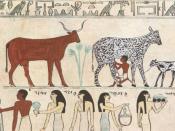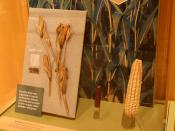In the Neolithic site of Tell Al-Felafel in the country of Arak, it is located in the middle of the country, there are many signs of an increase in social and economic complexities. If given the chance this village would have and did grow in population over time. The main examples for this include the findings at the buildings and the discoveries at the graves in the cemetery.
To show support for the increase in the social complexities and the growth in population Childes gives evidence for the emergence of urban life, which can be used as a checklist. First thing to focus on is the Primary characteristics, or fundamental changes.
These are the basic elements that are needed for population growth. Full - time specialization of labor is shown because there is evidence showing that surplus allowed support for full-time craftsmen. For example in building A, in both rooms 1 and 2, there was pottery found.
Some of the pots found were course and others painted. Also inside the main room of room 2, two wooden boxes and woolen cloths were found. In a couple of graves they found jewelry that people were warring and being buried in.
The next point that Childes talks about for the emergence of urban life is the concentration of surplus. Implying; social means for collection, storage, and distribution.
In Tell Al-Felafel there are what seem to be rooms that are for storage only. This room would be able to store the village surplus, which would be the concentration of surplus.
Class structural society is an other on of Childe's urban emergence. There are four different sub - topics within this step. The four are; privileged ruling class, military functionaries, merchant and craftsmen, and farmers and herders. In the Tell Al-Felafel there are signs...


